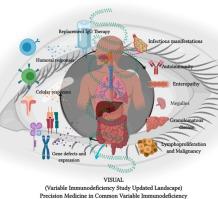当前位置:
X-MOL 学术
›
Immunol. Lett.
›
论文详情
Our official English website, www.x-mol.net, welcomes your
feedback! (Note: you will need to create a separate account there.)
Variable immunodeficiency study: Evaluation of two European cohorts within a variety of clinical phenotypes.
Immunology Letters ( IF 3.3 ) Pub Date : 2020-04-25 , DOI: 10.1016/j.imlet.2020.03.006 Kissy Guevara-Hoyer 1 , Julia Vasconcelos 2 , Laura Marques 3 , Antonio Alexandre Fernandes 3 , Juliana Ochoa-Grullón 1 , Antonio Marinho 4 , Teresa Sequeira 4 , Celia Gil 5 , Antonia Rodríguez de la Peña 6 , Irene Serrano García 7 , M José Recio 8 , Miguel Fernández-Arquero 1 , Rebeca Pérez de Diego 9 , José Tomas Ramos 5 , Esmeralda Neves 2 , Silvia Sánchez-Ramón 1
Immunology Letters ( IF 3.3 ) Pub Date : 2020-04-25 , DOI: 10.1016/j.imlet.2020.03.006 Kissy Guevara-Hoyer 1 , Julia Vasconcelos 2 , Laura Marques 3 , Antonio Alexandre Fernandes 3 , Juliana Ochoa-Grullón 1 , Antonio Marinho 4 , Teresa Sequeira 4 , Celia Gil 5 , Antonia Rodríguez de la Peña 6 , Irene Serrano García 7 , M José Recio 8 , Miguel Fernández-Arquero 1 , Rebeca Pérez de Diego 9 , José Tomas Ramos 5 , Esmeralda Neves 2 , Silvia Sánchez-Ramón 1
Affiliation

|
INTRODUCTION
Given the wide heterogeneity of common variable immunodeficiency (CVID), several groups have proposed clinical and immunological classifications to better define follow-up and prognostic algorithms. The present study aims to validate recent clinical and laboratory algorithms, based on different combinations of CVID biomarkers, to provide more personalized treatment and follow-up strategies.
METHODS
We analysed clinical and immunological features of 80 patients with suspected or diagnosed CVID, in two reference centres of Portugal and Spain. Clinical manifestations were categorized into clinical phenotyping proposed by Chapel et al. [1] that included cytopenia; polyclonal lymphocytic infiltration; unexplained enteropathy; and no disease-related complications.
RESULTS
76% of patients in our cohort entered one of the four categories of clinical phenotyping, without overlap (cytopenia; polyclonal lymphocytic infiltration; unexplained enteropathy; and no disease-related complications). The most prominent phenotype was "cytopenia" (40%) followed by "polyclonal lymphocytic infiltration" (19%). The remaining 24% patients of our cohort had overlap of 2 clinical phenotypes (cytopenia and unexplained enteropathy mainly). A delay of CVID diagnosis in more than 6 years presented 3.7-fold higher risk of developing lymphoproliferation and/or malignancy (p < 0.05), and was associated with increased CD8+CD45RO + T-lymphocytes (p < 0.05). An association between decreased switched-memory B cells with lymphoproliferation and malignancy was observed (p < 0.03 and p < 0.05, respectively). CD4 + T-lymphocytopenia correlated with autoimmune phenotype, with 30% prevalence (p < 0.05). HLA-DR7 expression was related to CVID onset in early life in our patients (13 vs 25 years), and DQ2.5 or DQ2.2 with unexplained enteropathy (p < 0.05).
CONCLUSIONS
The phenotypic and genetic study is crucial for an adequate clinical orientation of CVID patients. In these two independent cohorts of patients, classification based in clinical and laboratory algorithms, provides more personalized treatment and follow-up strategies.
中文翻译:

可变免疫缺陷研究:在各种临床表型内评估两个欧洲队列。
引言鉴于常见可变免疫缺陷症(CVID)的广泛异质性,一些小组提出了临床和免疫学分类法,以更好地定义随访和预后算法。本研究旨在基于CVID生物标志物的不同组合来验证最近的临床和实验室算法,以提供更多的个性化治疗和随访策略。方法我们在葡萄牙和西班牙的两个参考中心分析了80例疑似或确诊为CVID的患者的临床和免疫学特征。临床表现被归类为Chapel等人提出的临床表型。[1]其中包括血细胞减少症;多克隆淋巴细胞浸润;无法解释的肠病;而且没有与疾病相关的并发症。结果我们队列中76%的患者进入了临床表型的四类之一,没有重叠(血细胞减少症;多克隆淋巴细胞浸润;无法解释的肠病;没有与疾病相关的并发症)。最突出的表型是“血细胞减少症”(40%),其次是“多克隆淋巴细胞浸润”(19%)。我们队列中其余24%的患者有2种临床表型重叠(主要是血细胞减少和无法解释的肠病)。超过6年的CVID诊断延迟表示出现淋巴增生和/或恶性肿瘤的风险高3.7倍(p <0.05),并且与CD8 + CD45RO + T淋巴细胞增加有关(p <0.05)。观察到开关记忆B细胞减少与淋巴增生和恶性肿瘤之间的相关性(分别为p <0.03和p <0.05)。CD4 + T淋巴细胞减少与自身免疫表型相关,患病率为30%(p <0.05)。HLA-DR7表达与患者早期生命(13岁对25岁)以及DQ2.5或DQ2.2伴有无法解释的肠病的CVID发作有关(p <0.05)。结论表型和遗传研究对于CVID患者的正确临床定位至关重要。在这两个独立的患者队列中,基于临床和实验室算法的分类提供了更多个性化的治疗和随访策略。结论表型和遗传研究对于CVID患者的正确临床定位至关重要。在这两个独立的患者队列中,基于临床和实验室算法的分类提供了更多个性化的治疗和随访策略。结论表型和遗传研究对于CVID患者的正确临床定位至关重要。在这两个独立的患者队列中,基于临床和实验室算法的分类提供了更多个性化的治疗和随访策略。
更新日期:2020-04-25
中文翻译:

可变免疫缺陷研究:在各种临床表型内评估两个欧洲队列。
引言鉴于常见可变免疫缺陷症(CVID)的广泛异质性,一些小组提出了临床和免疫学分类法,以更好地定义随访和预后算法。本研究旨在基于CVID生物标志物的不同组合来验证最近的临床和实验室算法,以提供更多的个性化治疗和随访策略。方法我们在葡萄牙和西班牙的两个参考中心分析了80例疑似或确诊为CVID的患者的临床和免疫学特征。临床表现被归类为Chapel等人提出的临床表型。[1]其中包括血细胞减少症;多克隆淋巴细胞浸润;无法解释的肠病;而且没有与疾病相关的并发症。结果我们队列中76%的患者进入了临床表型的四类之一,没有重叠(血细胞减少症;多克隆淋巴细胞浸润;无法解释的肠病;没有与疾病相关的并发症)。最突出的表型是“血细胞减少症”(40%),其次是“多克隆淋巴细胞浸润”(19%)。我们队列中其余24%的患者有2种临床表型重叠(主要是血细胞减少和无法解释的肠病)。超过6年的CVID诊断延迟表示出现淋巴增生和/或恶性肿瘤的风险高3.7倍(p <0.05),并且与CD8 + CD45RO + T淋巴细胞增加有关(p <0.05)。观察到开关记忆B细胞减少与淋巴增生和恶性肿瘤之间的相关性(分别为p <0.03和p <0.05)。CD4 + T淋巴细胞减少与自身免疫表型相关,患病率为30%(p <0.05)。HLA-DR7表达与患者早期生命(13岁对25岁)以及DQ2.5或DQ2.2伴有无法解释的肠病的CVID发作有关(p <0.05)。结论表型和遗传研究对于CVID患者的正确临床定位至关重要。在这两个独立的患者队列中,基于临床和实验室算法的分类提供了更多个性化的治疗和随访策略。结论表型和遗传研究对于CVID患者的正确临床定位至关重要。在这两个独立的患者队列中,基于临床和实验室算法的分类提供了更多个性化的治疗和随访策略。结论表型和遗传研究对于CVID患者的正确临床定位至关重要。在这两个独立的患者队列中,基于临床和实验室算法的分类提供了更多个性化的治疗和随访策略。











































 京公网安备 11010802027423号
京公网安备 11010802027423号